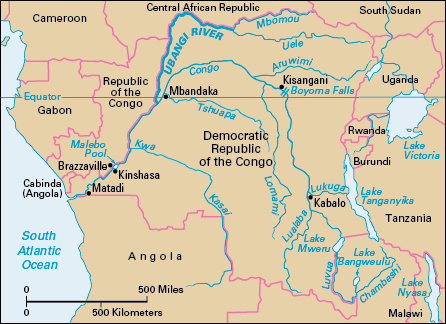Ubangi River << yoo BANG gee >> is the chief northern tributary of the Congo River in Africa. The Ubangi—also spelled Oubangui—is formed by the union of the Mbomou and Uele rivers, and empties into the Congo near Lake Tumba in the Democratic Republic of the Congo (DRC). With its main headstream, the Mbomou, the Ubangi River is about 1,400 miles (2,250 kilometers) in length. For about 700 miles (1,100 kilometers), the Ubangi forms the boundary separating the DRC from the Republic of the Congo on the west, and from the Central African Republic on the northwest. The southern part of the river is navigable throughout the year.

French colonists established the city of Bangui on the Ubangi River in 1889. In 1894, Bangui became part of the newly created territory of Ubangi-Shari, part of a federation of colonies known as French Equatorial Africa. The Ubangi River formed part of the border between French Equatorial Africa and the Belgian Congo, now the DRC. In 1960, Ubangi-Shari gained independence as the Central African Republic.
See also Bangui; Central African Republic; French Equatorial Africa.
